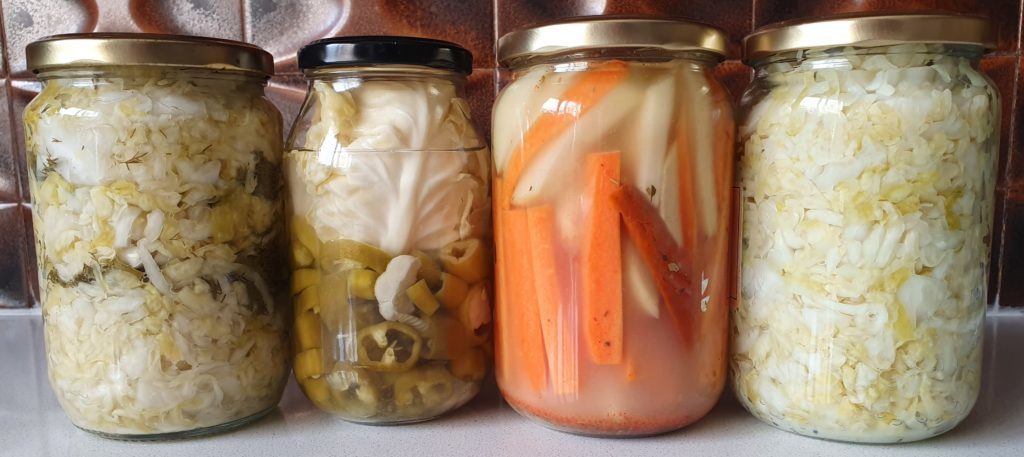Fermentation is the transformation of food through enzymes produced by types of microorganisms. The types of microorganisms that we use in fermentation are bacteria, yeasts,
The word fermentation comes from the Latin word “fervere”, that means “to boil”. The ancient Romans saw the bubbling of grapes that reminded them of boiling and described the process using an analog of what they saw.

Fermentation is a traditional way of preserving foods that have been around for thousands of years. The earliest archaeological evidence of fermentation is 13,000-year-old residues of a beer, with the consistency of gruel, found in a cave near Haifa in Israel. Evidence of fermented foods was found all over the world, from China all the way to Iran, Egypt,
Fermented foods benefited humans in the ancient world from in two ways. The first is conservation; the agricultural revolution has created leftovers of food that could have been saved for periods of difficulty in obtaining food. Fermentation was a safe and qualitative way of preserving.
The second was nutritious; when we started to keep food in the silos, the quality of the food we ate dropped, and we ate less than the fresh and ripe food we ate when we hunted gatherers. Lactic acid plays an important role in the decomposition of food in the human digestive system, the acidity it creates and the breakdown of acids helps food digest. A process of fermentation breaks down various amino acids and sugars and makes them more suitable for digest in the human digestive system.
Nevertheless, we are people who live in the “post Louis Pasteur era”. We perceive every bacterium as a pest that must be acted upon in order to kill it.
As children, we grow up to be wary of germs. We are taught that if we are ill it is because of bacteria and that we do not drink from a friend’s bottle so as not to transfer bacteria. In general, we learn that bacteria are bad and you have to be careful.
As adults, we make sure to disinfect any surface work and for killing all kinds of bacteria that exist, we do not even recognize that there are good types of bacteria.
When it comes to food, we’re even more sensitive to the concept of bacteria. The first thing most people think of when they hear the word bacteria and food together, is food spoilage, bad taste in the mouth, stomachache and feeling bad. It is justified food spoilage is a process in which different microorganisms, such as fungi or bacteria, feed on food and make it inedible to humans. It is also a process of fermentation, like the one that occurs in compost – when our food remains turned into soil.
But what we’re dealing with here are bacteria that have benefits for us. There are bacteria that can make food easier to digest for us. In fact, there are bacteria that are actually dealing with the digestion of food within our body and without them, there will be no digestive process. We can create a similar process outside our body, which also brings food preservation and makes it easier to digest. In the fermentation process of food preservation, we deliberately create conditions that are not conducive to the development of certain microorganisms and are more conducive to the development of others, thereby creating a system that protects the food and makes it more easily digestible. For more in-depth information about Safely Fermenting Food at Home see Extension Food Safety Fact Sheet- September 2015.
The book “The Noma Guide to Fermentation” has an entertaining explanation of how fermented works and how it is kept safe for consumption.
“There’s a thin line between rot and fermentation, and that line might best be understood as an actual line, like the kind you’d find outside a nightclub. Rot is a club where everyone gets in: bacteria and fungi, safe or unsafe, flavor enhancing or destructive. When you ferment something, you’re taking on the role of a bouncer, keeping out unwanted microbes and letting in the ones that are going to make the party pop.”
Lacto-fermented foods are fermented by lactobacillus bacteria, which is a category of beneficial bacteria that feed on sugar and that produces lactic acid as a byproduct. This is why
Lactic acid bacteria are present all over the world. You can find on the skin of fruits and vegetables, and even on the skin of humans.

We use them for their ability to convert sugar into
For more in-depth and thorough information check out the US National Library of Medicine National Institutes of Health
- Vegan fermented cream cheese
- Lacto fermented vegetables
- Fermented tomatoes – ‘Conserva Cruda di Pomodoro’
- Vegan cheese Labaneh- cashew cheese
- Middle Eastern Amba recipe
- Top 5 Food Fermentation Books
- Beginners Guide for homemade Lacto fermented sauerkraut
This site is a participant in the Amazon Services LLC Associates Program and contains affiliate links to products. We may receive a commission for purchases made through these links.
